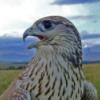-
Content Count
91 -
Joined
-
Last visited
Community Reputation
0 NeutralAbout Rentomski
-
Rank
Born Hunter
-
Yes, provided he has known yov for at least two years.
-
Nothing wrong with that at all. Last year I shot a huge Roe doe at about 240 yards. BTW .308 is quite capable of dealing with those kind of shots. I had a nice stable position, but I dithered about taking the shot for some 20 minutes...But, maybe, it might just give the wrong idea to some. Deer killing at long ranges is not stalking. Maybe I could shoot more deer at 300+ yards; yet I would never consider taking that kind of shot. As a previous poster has stated, what you can do on the range does not equate to what is needed in the field.
-
Books are not enough... Hands on with real hawks is what you need; don't think the nicely manned bird at a centre is anything like a 16 week old Harris' straight out the aviary.
-
Thank you Sir! Good to see that someone agrees with me.
-
In all my years of stalking, I have only shot two deer at over 180-240 yards. Only because I could not get any closer. Make a duff shot, as we all have, and you will have severe problems making a good second shot/following up etc. Spend the time to get close is the whole point of deer stalking; most of mine are shot at some 60- yards.
-
Double brass tail mount glued to a deck does everything; less for the bird to pick at and room for the tag. KISS. Remember that Harris' shake their tails all the time!
-
D18 C D82 C H43 C H50 C
-

oops! have I damaged my bore???? (.17 HMR)
Rentomski replied to danebrewer10's topic in Rimfire, Centrefire & Shotguns
Very true! Went to a Deer Commission best practice day last October. A very interesting talk from a riflesmith. "How many of you use boresnakes?" he asked. About 3/4 of those present indicated that they used the things. "I get a lot of work because of them" he replied. Then he handed round a rifle barrel with what was left of a boresnake wedged in place and impossible to remove. Great for shotguns and smoothbores as he said, but a little too much carbon fouling in a rifle, then try to clean it with a boresnake and one could be looking for a new barrel.... Worrying, but not as -

Glass choice for new Deer Rifle
Rentomski replied to lgray88's topic in Rimfire, Centrefire & Shotguns
Mine does exactly the same and did take a bit of getting used to; a case of what you get with a first focal plane reticle. I'm not bothered about it now as I leave it on 8x just about all the time, but I can't fault the build quality or the low light ability of the scope. I believe that Docter do make some scopes, primarily for target shooting, with the reticle in the second focal plane so the apparent size of the reticle remains constant across the zoom magnification range. -

Glass choice for new Deer Rifle
Rentomski replied to lgray88's topic in Rimfire, Centrefire & Shotguns
Wise words indeed! I have a Docter 3-12x56 on my .308 which is a good piece of glass, if I can see a deer in poor light with my Swarovski binos I can also see it through the scope. Although it does tend to spend all its time set on 8x..... -
Yes indeed an excellent book. Also worth a look: Understanding the Bird of Prey by Nick Fox. Not a beginners book, but covers all aspects of falconry and captive birds of prey in considerable technical detail. Falconry and Hawking by Phillip Glasier. Probably the classic British book on the subject. Training birds of Prey by Jemima Parry-Jones. I don't agree with everything she advocates, but it is a well written and informative book.
-
Call your local Fireams Licensing. Unfortunately even though there is Home Office guidance on the matter: all Police Forces interpret the 'guidance' as it suits themselves. Good luck anyway!
-
The .243 appeared at about the same time as the .244 Remington. .243 on a .308 Winchester case and the .244 on the .257 Roberts case The .244 was loaded, in the USA, to start off with a 90 grain bullet as the heaviest bullet, so it quickly became regarded as a varmint only calibre. The .243 was available with a 105 grain load from the off and rapidly gained a reputation as a good flat-shooting, minimal recoil calibre for deer. .243 is still here. Where is the .244?

